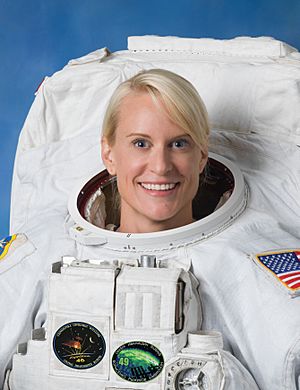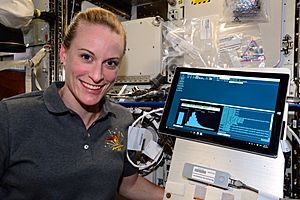Kathleen Rubins facts for kids
Quick facts for kids
Kate Rubins
|
|
|---|---|

Rubins in 2018
|
|
| Born | October 14, 1978 Farmington, Connecticut, U.S.
|
| Space career | |
| NASA astronaut | |
|
Time in space
|
300d 1h 31m |
| Selection | NASA Group 20 (2009) |
|
Total EVAs
|
4 |
|
Total EVA time
|
26h 46m |
| Missions | Soyuz MS-01 (Expedition 48/49) Soyuz MS-17 (Expedition 63/64) |
|
Mission insignia
|
 |
| Scientific career | |
| Fields | Biochemistry |
| Thesis | A Genome-Wide Analysis of the Host and Viral Responses during Poxvirus Infection (2005) |
| Doctoral advisor | Patrick O. Brown |
Kathleen Hallisey "Kate" Rubins (born October 14, 1978) is an American scientist and NASA astronaut. She became the 60th woman to fly in space. She launched on a Russian Soyuz spacecraft to the International Space Station (ISS) on July 7, 2016. She returned to Earth in Kazakhstan on October 30, 2016.
Kate Rubins was a crew member for two long missions on the ISS. These were Expedition 48/49 and Expedition 63/64. She has spent a total of 300 days, 1 hour, and 31 minutes in space. This is the fourth longest time in space for a U.S. female astronaut.
Contents
About Kate Rubins
Kate Rubins was born in Farmington, Connecticut. She grew up in Napa, California. When she was in seventh grade, she did chores to save money for a trip to Space Camp. This camp made her want to study more math and science. In July 2016, she became the third woman who went to Space Camp to fly into space.
Kate Rubins finished Vintage High School in Napa, California, in 1996. She earned a degree in molecular biology from the University of California, San Diego. Later, she received a Ph.D. in cancer biology from Stanford University.
From a young age, Rubins dreamed of becoming an astronaut. She first thought she needed to be a fighter pilot. But then she became interested in viruses and microbiology. She decided to study those first. Her hobbies include flying airplanes, skydiving, and scuba diving. She also competed in triathlons.
Microbiology Research
Before becoming an astronaut, Kate Rubins was a microbiologist. She studied how viruses affect the body. She did research on HIV-1 at the Salk Institute. She also helped create a model to study smallpox infection. This work was done with the U.S. Army and the Centers for Disease Control and Prevention.
Rubins also led a lab at the Whitehead Institute for Biomedical Research. Her team studied viral diseases common in Africa. They researched viruses like Ebolavirus and Marburgvirus. She also worked on ways to treat these diseases.
Dr. Rubins also studied how space radiation affects astronauts. This research helps NASA understand the risks of long space missions. Another study she was part of looked at the life cycle of viruses, including the smallpox virus. This research helps scientists find treatments for diseases like mpox.
While on the International Space Station, Dr. Rubins researched how microgravity affects RNA. This was part of the WetLab-2 project. It was one of the first successful microbiology experiments done in space. This research is very important for future space exploration. It helps scientists analyze samples from space.
NASA Career
Kate Rubins was chosen by NASA in July 2009. She was one of 14 new astronauts. Her training included learning about the International Space Station (ISS) systems. She also trained for spacewalks and robotics. She learned to fly T-38 jets and practiced survival skills.
She became the 60th woman in space when she launched on Soyuz MS-01 in July 2016. As a child, she loved learning about constellations with her dad. She was always fascinated by science and exploring.
In 2021 and 2022, Rubins took part in the ESA PANGAEA program. This program trains astronauts in geology. She trained in different places, including Italy, Germany, and Norway. This training helps astronauts explore other planets.
First Space Mission: Expedition 48/49
Rubins went to space for the first time on July 7, 2016. She flew on the new Soyuz MS spacecraft. Her crewmates were Russian cosmonaut Anatoli Ivanishin and Japanese astronaut Takuya Onishi.
In August 2016, Rubins made history. She became the first person to sequence DNA in space. She used a special hand-held device called the MinION. This device can read the DNA sequences of living things. This experiment showed that DNA sequencing is possible in space. It could help astronauts identify microbes or diagnose illnesses in space.
During her first mission, she also did two spacewalks. She spent 12 hours and 46 minutes outside the station. She worked with astronaut Jeffrey Williams. On her first spacewalk, she helped install a new docking adapter. This adapter allows U.S. commercial spacecraft to connect to the ISS. On her second spacewalk, she installed new cameras. Rubins also helped capture the SpaceX Dragon spacecraft. This spacecraft brought supplies and took experiment samples back to Earth.
Rubins returned to Earth on October 30, 2016. She had spent 115 days in space.
Second Space Mission: Expedition 63/64

Rubins launched on her second mission on October 14, 2020. This was her 42nd birthday! She flew with Russian cosmonauts Sergey Ryzhikov and Sergey Kud-Sverchkov. She returned to Earth on April 17, 2021.
Rubins was on the ISS during the 2020 United States elections. She cast her vote from space.
During this mission, she completed two more spacewalks. Her third spacewalk was with Victor J. Glover. Her fourth spacewalk was with Soichi Noguchi in March 2021.
Research on Expedition 63/64
On her second trip to the ISS, Rubins continued research for the Cardinal Heart experiment. This study looked at how microgravity affects heart tissues. Microgravity can cause changes in cells and tissues. This research helps us understand heart problems on Earth. It could also lead to new treatments. Dr. Rubins and other scientists created 3D heart tissue for this study.
Artemis Program
Kate Rubins is part of the Artemis program. NASA announced her as one of the astronauts on the Artemis Team. The Artemis program aims to send the first American woman to the Moon. It also plans to explore the Moon's surface. This research will help us understand if humans can live on Mars in the future.
Awards and Honors
Kate Rubins has received several awards for her work. These include:
- Popular Science's Brilliant Ten (2009)
- National Science Foundation Predoctoral Fellowship (2000)
- Stanford Graduate Fellowship - Gabilan Fellow (2000)
- UCSD Emerging Leader of the Year (1998)
- Order of Omega Honor Society Scholarship Award (1998)
See also
 In Spanish: Kathleen Rubins para niños
In Spanish: Kathleen Rubins para niños


